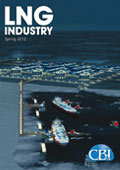Editorial comment
In December, I accompanied the Winter issue of LNG Industry to the World Petroleum Congress in Doha, Qatar. During my time in Doha I had the privilege of visiting Ras Laffan Industrial City, which was a unique experience. The site was astonishing in its scale, having been transformed from barren desert into a technologically sophisticated energy hub supplying all corners of the world. It is amazing to consider that the transformation of the Qatari economy on the back of natural gas has occurred in such a relatively short period of time; Qatar’s North gas field was discovered in 1971 and Ras Laffan Industrial City began operations in 1996. In that time frame, the country’s GDP has increased from approximately US$ 300 million in 1971 to US$ 110 billion in 2008. And they have plenty of shiny skyscrapers to show for it...
Register for free »
Get started now for absolutely FREE, no credit card required.
Naturally, industry players spend a lot of time conjecturing which region or country is likely to be ‘the next big thing.’ Australia has taken the limelight away from Qatar somewhat recently, and continues to develop at a promising rate, with huge amounts of money being invested in ‘first-of-a-kind’ projects such as Shell’s Prelude FLNG project; the largest floating facility in the world. Inpex and Total are proceeding with their joint development of the Ichthys project – one of the largest onshore gas facilities in the world. The companies have arranged US$ 70 billion worth of sales agreements with Japan for 15 years worth of LNG production. BG Group has recently announced it will sell down its stake in the Queensland Curtis LNG project for up to US$ 2 billion. The company intends to sell approximately 20% of its existing 93.75% stake in the project, which is set to be the first in the world to produce LNG from coalbed methane.
Demand for LNG from Asia continues apace; reports have claimed the region will expand its regasification capacity by almost 35% between 2010 and 2015. China aims to bring three LNG import terminals online in 2012 and in the same year Japanese demand for LNG is likely to increase by more than 25%. China is likely to be the second largest LNG importing country by 2020, after Japan.
The world keeps looking for the next big supplier. But aside from Australia, another region that is gaining some attention as an emerging potential exporter is the eastern coast of Africa. Shell has recently agreed a £992.4 million bid for Cove Energy, a small oil and gas exploration company with interests in east Africa. Cove currently owns an 8.5% stake in a large gas field recently discovered offshore Mozambique. Anadarko Petroleum, Cove and Eni have all made huge gas discoveries in this area. According to Financial Times correspondent Guy Chazan, “Their two fields combined could contain up to 60 trillion ft3 of recoverable resources of gas – nearly as much as Kuwait’s entire reserves. That should be enough to turn Mozambique into a key exporter of LNG, to China and India’s fast growing economies.” As the gas majors move into the area and buy out smaller companies such as Cove, the pace of exploration and LNG development in the region will inevitably accelerate. Chazan points out that, “Fewer than 500 wells have been drilled in east Africa, compared with some 20 000 in the north and nearly 15 000 in the west of the continent.” Maybe the LNG sector could start contemplating a new multi million dollar question: if Australia is the next Qatar, could Mozambique be the next Australia? We’ll have to wait and see…

